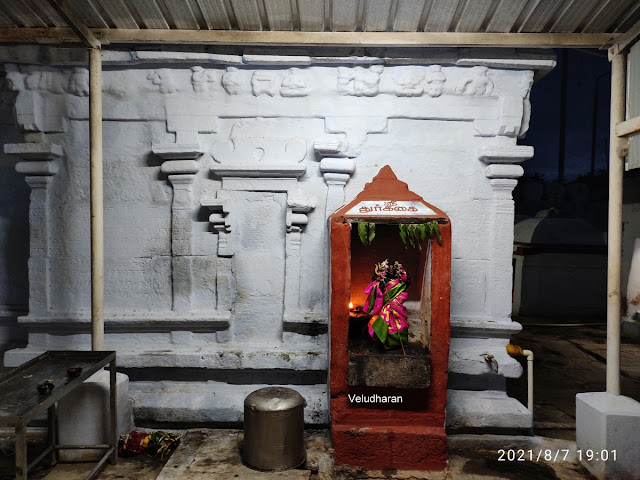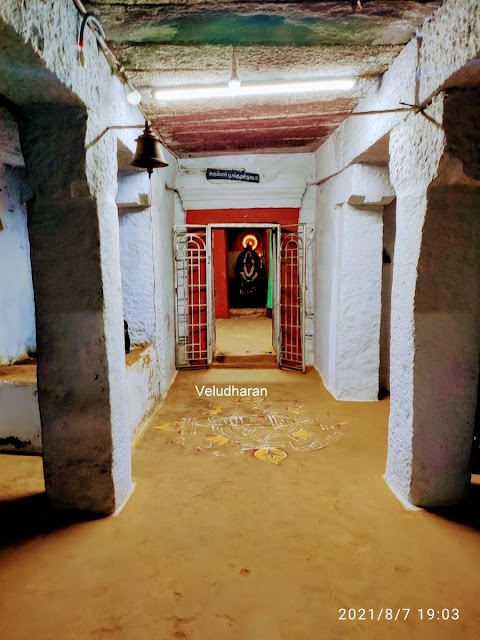The
visit to this Sri Ponsolisvarar Kovil, at Palangarai, was a part of a Heritage
visit to the temples, heritage sites, and Hero stones from Vijayamangalam to
Avinashi, on 07th August 2021. This place was called “Palangaraya
Nallur” during the Chozha period, but is now called “Palangarai”.
Moolavar : Sri PonsolisvararConsort : Sri Surumbar Poonguzhali
Some
of the salient features of this temple are….The
temple faces east with a Deepa Sthambam. Nagars with Vinayagar are on the
right side of the Deepa Sthambam under the Peepal tree. An entrance mini gopura is after the Deepa Sthambam. Balipeedam
and Rishabam are after the entrance. There
are no images in the koshtams. Dakshinamurthy and Durgai are installed at a later date.
In
praharam Suriyan, Chandran, Bhairavar, Nalvar, Navagrahas, Chandikeswarar,
Vinayagar, Sri Valli Devasena Arumugar (in a single stone with Thiruvasi), and
Pancha Lingas. Ambal is in a separate temple facing east. Sri Nithya Kalyana
Srinivasa Perumal with Sridevi & Bhudevi sannidhi with Garudan, Madhvacharya, and Ramanujar are in Ambal’s Mukha mandapam.
ARCHITECTUREThe
temple consists of the sanctum sanctorum, antarala, and ardha mandapam. The
adhistanam is of a simple pada bandha adhisthana with three patta kumuda. A
single-tier vesara vimana is over the sanctum sanctorum. Kumbha banjara is in the
antarala niche.
The
other parivara shrine vimanas are of Nagara style. Temple outside walls are
built like Fort walls with bastions.
HISTORY AND
INSCRIPTIONSAs per Chozhas Poorva Pattayam, the Naga Kannikapuri
and a fort were built by Cheraman Perumal, and the Chozha King near Thirumurugan
Poondi and Nagadeva Mandradi was made to be in charge of the place, and Nalla
Thambi Pillai as Kanakkar. The
Thirumurugan Poondi inscription also mentions that there was a fort with
soldiers staying near Palangarai. To support this claim, we can still see that the
temple’s compound walls are built like fort walls. As per the Chozha Poorva
Pattaya, Karikar Chozha and Cheraman Perumal constructed 7 big and 360 small
Shiva Temples in the Kongu region in the year Kaliyugam 3556, ie, 455 CE. However, the
experts believe that the original temple might have been constructed in the 10th century. Later extended
during the Vijayanagara period. The river called Agnima Nadhi/River was flowing on the
back side of the temple during ancient times. Now it has shrunk to a canal, and
a check dam was constructed in recent years.
As per the inscriptions, this place was
called “Palangarainallur” and Lord Shiva was called “Sri
Munthondreeswaramudayar”, and the same was corrupted to the present name of “Sri
Ponsolisvarar”. This place was in Vadaparisara Nadu, one of the 24 Nadus of
Kongu mandalam. The Ambal shrine was built
during the 13th Century.
The Inscriptions recorded from this
temple belong to Chozha Kings Veera Rajendran, Vikrama Chozha, and Vijayanagara
King Achchutharaya.
Veerarajendran’s 7th reign
year (1214 CE) inscription records Merchant group (வணிகமடியார்) gave a gift of 48 kalam paddy, and
Veera Narayananallur Kurichi Villagers promised offerings / Naivedyam to
Lord Shiva Munthondreeswarar. This inscription mentions a place called
Anaichupoondi.
Another Veera Rajendran’s 25th
reign year (1232 CE) inscription records the endowment of special Naivedyam
to Lord Shiva during the procession for
which paddy was gifted by Kali of Avinashi, who belongs to the Kailkolar sect / Clan. (measurement mentioned as Pazhanchalagai).
Veera Rajendran’s 7th reign
year (1214 CE) inscription records that Munthondreeswara Udayar temple’s
Bhattan – A Brahmin - was given liberty for the land given to him as Archana Bhogam to use to sell or mortgage, or donate. The inscription is
incomplete with a lot of mistakes.
The Vijayanagara King Achchutharayar’s period (1540 CE) inscription records
that during Achchutharayar’s official VaradhapaNNa Nayakar period, the people
of Vadaparisara nadu and the Karai (Palangarai) Villagers gave a gift of Land
to this temple. The inscription mentions Thulukkar – Muslims..? and the
inscription is damaged in many places.
During British rule, a British officer with his
soldiers camped near the temple. On that night, their tents were washed away by
the flood in the river. The British officer prayed to Vinayagar to save them.
To their prayer, the Vinayagar ordered the river to give way to them. As a part of
Thanksgiving, the British officer ordered to pay Rs 2/day for poojas vide order no 3136 B.P.G.O No 1625
dated 25.11.1899. It was said that this has continued to date. This Vinayagar
is near the river. (to be verified..?)
LEGENDSDevotees pray to Lord Shiva and Ambal for a Child boon, to remove marriage obstacles. It was told that a Parihara pooja
will be conducted on all Pournami (Full moon) days at Rs 2000, and it was told that marriages
will be conducted within 90 days. Hope the Parihara pooja has to be conducted for Sri Nithya Kalyana Srinivasa Perumal, the same name as Thiruvidanthai Temple Perumal's name. In this place, also Similar Poojas will be done for marriage boons.
POOJAS AND CELEBRATIONSApart from regular poojas, special
poojas are conducted on Pournami, Amavasai (No moon days), Kiruthigai,
Sashti, Pradosham, Chaturthi, Sankatahara Chaturthi, Theipirai Ashtami,
Ekadasi, Shivaratri, Maha Shivaratri, Karthigai Deepam,
TEMPLE TIMINGSThe temple will be kept open from 07.00 hrs to 12.00 hrs, and from 17.00 hrs to 20.00 hrs.
CONTACT DETAILSGurukkal Prakash’s mobile number
+919787592149 may be contacted for further details.
HOW TO REACHThe temple is on the Perundurai –
Coimbatore road and Salem Kochi Highway. (On the service road)The temple is 5.2 km from Avinashi,
14.8 km from Tiruppur, 36 km from
Perundurai, 47 km from Coimbatore, 57 km from Erode, and 459 km from Chennai.The nearest Railway Station is Tiruppur.
LOCATION OF THE TEMPLE: CLICK HERE
Veera Rajendran’s 7th reign
year (1214 CE) inscription records that Munthondreeswara Udayar temple’s
Bhattan – A Brahmin - was given liberty for the land given to him as Archana Bhogam to use to sell or mortgage, or donate. The inscription is
incomplete with a lot of mistakes.






















No comments:
Post a Comment